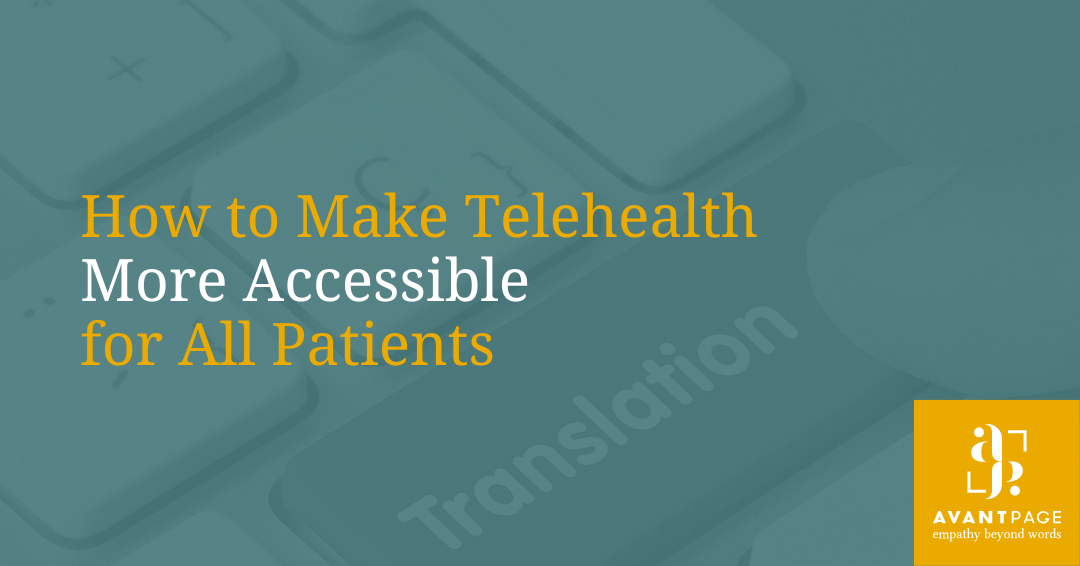Telehealth services have become a convenient way for patients and healthcare providers to address health issues. And while telehealth and telemedicine are excellent ways to receive care for many people, research shows that telehealth services aren’t always accessible for individuals with disabilities. This includes not just the telehealth appointment itself but also the steps of the patient journey leading up to the appointment (e.g., finding a doctor, filling out forms, etc.) and the post-appointment (e.g., getting a prescription, scheduling follow-up tests, reading materials, etc.). While many different types of disabilities exist (e.g., hearing, visual, cognitive, motor and dexterity, and speech), we’ll focus on hearing and visual disabilities for this blog.
A survey by the American Foundation for the Blind (AFB) found that 70% of 488 adults in the U.S. who are blind, have low vision or are deafblind tried to use telemedicine, but 57% had problems accessing the platform.
In addition, a research report by the AFB showed that most of the material provided by healthcare providers is not accessible to them. This results in difficulties with prescription labels, pre-surgery instructions, and other types of materials.
“We need accessible healthcare mobile apps and websites. We need technology to represent graphical information in a format we can understand.” —Congenitally VI White male, aged 45 to 54 years, with no additional disabilities (p.55 Flatten Accessibility Report)
Yet healthcare providers can take steps to make their services more accessible for individuals. We’ll look at what should be reviewed and made accessible along the patient journey.
Pre-Telehealth Appointment
Finding a physician and initiating an appointment are the first few steps in the patient journey. In general, people turn online to do this research.
Accessibility Considerations for Healthcare Providers
Think about all the steps a patient must take do before a telehealth visit. How can you make those steps more accessible? For example:
- Website accessibility for Section 508 of the Rehabilitation Act of 1973 requires Federal agencies to make electronic and information technology accessible to those with disabilities. The gov websiteprovides guidance and training for authors and developers of electronic documents and information to make their content accessible.
In addition, the World Wide Web Consortium (W3) created Web Content Accessibility Guidelines (WCAG) that provide recommendations for making websites more accessible. WCAG 2.2 is the latest version. Accessibility includes features like making navigation available through keyboards, providing alternative text for visuals, and avoiding using colors alone to distinguish content.
Avantpage offers Accessibility Services that work within your budget by running a report covering accessibility features to provide to internal teams for implementation, or by offering a full-service report and implementation of the accessibility features required. Learn more about what our report includes by requesting to speak with our accessibility expert.
- Review all patient paperwork, such as outreach content, patient forms, billing agreements, telehealth information, and more, for accessibility. Make sure that there are options on the initial paperwork for patients to note that they need a sign language interpreter. In addition, include an area for patients to provide more information about what they might need. For example, for those who are blind or have low vision, ask if they’d like braille, audio or large print communications. For deaf or hard-of-hearing patients, ask what type of sign language they need. Also provide an area for general needs. Here are some guidelines from Section 508.
During the Telehealth Appointment
The telehealth visit should be viewed from the patients’ perspective and also from an internal technical perspective.
Accessibility Considerations for Healthcare Providers
How can your organization make its telehealth services more accessible during the appointment? The patient needs to receive accessible log-in instructions, troubleshooting information, contact information for technical help, and information on how to cancel or reschedule.
Your organization’s IT team should implement the following technical features to ensure the telehealth visit is accessible for users who are blind, have low vision, are deaf, or are hard-of-hearing. This will ensure the patient is able to connect into their telehealth appointment.
- Keyboard accessibility
- Captioning and transcript options
- Low-vision capabilities like screen magnification, contrast controls, and font resizing capabilities
- Screen reader functionality
- API integration or connectors to remote interpreting services (3rd party or internal)
If you would like help assessing these areas, Avantpage is happy to find a solution to match your budget and timeline. Request a quote today.
Post-Telehealth Appointment
The patient experience doesn’t end with the telehealth appointment. There might be instructions, follow-up appointments to schedule, tests to schedule, care instructions, updates in patient portals, and more.
Accessibility Considerations for Healthcare Providers
While the post-visit process varies for each individual, the same concepts that we mentioned earlier also apply here.
- Make sure any electronic documents are made accessible through document remediation services.
- Ensure the patient has an accessible way of getting back in touch with your organization after the appointment whether for requests, questions, new appointments, feedback, or otherwise.
- Provide over-the-phone or video-remote interpreters for verbal communication.
- Prescriptions and instructions may need to be provided in alternative formats. Anticipate and make sure the necessary professionals know this for accessibility.
- Make sure the patient intake information is continuously utilized for communications so the patient receives all communications in their preferred format.
Conclusion
Healthcare providers can greatly improve the patient journey by providing accessible materials and online experience. These materials should provide the best accessibility and user experience.
We provide a full range of services for healthcare providers to accommodate those with disabilities. We can review your current client-facing content for accessibility and work together with you to make changes to websites, digital content, and other types of content along the patient journey. Visit our website to learn more about how we can help healthcare providers accommodate their patients with disabilities and improve their patient journeys, and contact us at [email protected] or (530) 750-2040.
